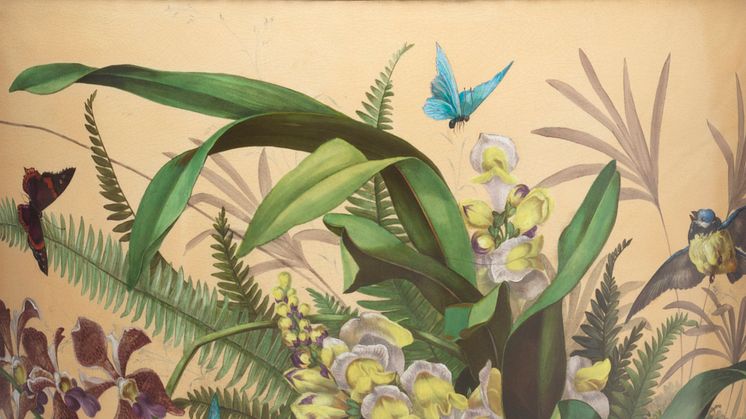
Press release -
Rörstrand exhibition urn donated to Nationalmuseum
Nationalmuseum has been gifted a large exhibition urn made at the Rörstrand porcelain works in Stockholm. Produced in 1884, the urn is decorated with delicate motifs by Anton Vogel. It has been donated to the museum by Lars Vogel, the artist’s grandson.
The urn is shaped like a classic amphora with ornamental handles. Evenly spaced, gold-painted decorative relief in Renaissance style frames the body, where exotic orchids, butterflies and hummingbirds are depicted in a naturalistic style. The decoration is the work of Anton Vogel (1859–1935), who moved from Germany to Sweden in 1883 to take up a position as decorator and teacher of porcelain painting at the Rörstrand works in Stockholm. The role of exhibition urns was to catch the eye of visitors at world’s fairs and generate astonishment at the size of the artefacts and their artistic or technical execution. Once visitors’ attention had been caught, they could view the manufacturer’s more conventional offerings. The exhibition urn recently donated to Nationalmuseum combines the manufacturer’s technical prowess in large-format work with the artist’s painting skills. It probably appeared at one or more of the world’s fairs in New Orleans, London, Barcelona or Paris in the 1880s, although which is unknown. In 1943 the urn appeared on loan in an exhibition at Nationalmuseum featuring Rörstrand porcelain over three centuries.
“Until now, the Nationalmuseum collection has lacked a 19th-century exhibition piece by Rörstrand,” said Micael Ernstell, curator of applied art and design at Nationalmuseum. “This generous gift is a welcome addition that fills an important gap in our ceramics collection.”
In 1889, Anton Vogel and Adolf Neuman (1849–1938) left Rörstrand to set up Stockholms Glasmåleri Neumann & Vogel, a business supplying stained glass to churches and grand building projects. Here too, Vogel had the opportunity to apply his artistic talents to the more spectacular pieces. The firm was lauded for the stained glass it exhibited at the 1893 Chicago world’s fair. One of these pieces, featuring a portrait of King Oscar II, has been in the Nationalmuseum collection since 1894 (NMK 42/1894).
Nationalmuseum receives no state funds with which to acquire design, applied art and artwork; instead the collections are enriched through donations and gifts from private foundations and trusts. The acquisition has been made possible by a generous gift from Lars Vogel, the artist’s grandson.
Inventory number
Anton Vogel, manufactured by Rörstrand, Urn, 1884. Flintware. NMK 29/2022.
Media enquiries
Micael Ernstell, curator, applied art and design, micael.ernstell@nationalmuseum.se, +46 8 5195 4392
Hanna Tottmar, head of press, press@nationalmuseum.se, +46 8 5195 4400
Categories
Nationalmuseum is Sweden’s museum of art and design. The collections comprise some 700 000 objects, including paintings, sculpture, drawings and graphic art from the 16th century up to the beginning of the 20th century and the collection of applied art and design up to the present day. Nationalmuseum’s responsibility is to preserve and make art accessible and provide knowledge. The museum was appointed the Swedish Museum of the Year 2022.

